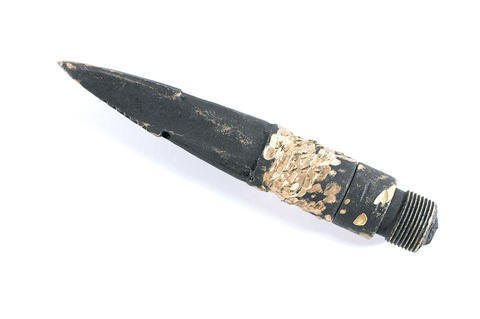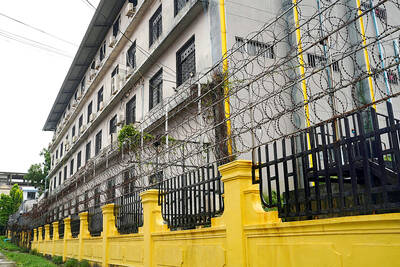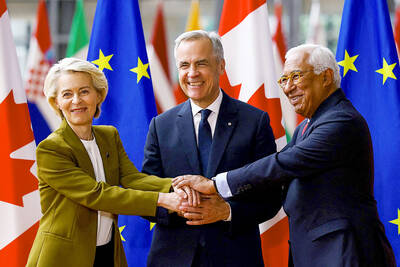A 45-tonne bowhead whale caught off the Alaskan coast last month had a weapon fragment embedded in its neck that showed it survived a similar hunt -- more than a century ago.
Embedded deep under its blubber was a 12.7cm projectile that has given researchers insight into the whale's age, estimated between 115 and 130 years old.
"No other finding has been this precise," said John Bockstoce, an adjunct curator of the New Bedford Whaling Museum in Massachusetts.

PHOTO: AP
Calculating a whale's age can be difficult and is usually gauged by amino acids in the eye lenses. It is rare to find one that has lived more than a century, but experts say the oldest were close to 200 years old.
The bomb lance fragment, lodged between the whale's neck and shoulder blade, was likely manufactured in New Bedford, Massachusetts, a major whaling center at that time.
The device exploded and probably injured the whale, Bockstoce said.
"It probably hurt the whale, or annoyed him, but it hit him in a non-lethal place," he said. "He couldn't have been that bothered if he lived for another 100 years."
The whale, which would have been born in about 1877, harkens back to a far different era. Bockstoce said he was impressed by notches carved into the end of the arrow used in the 19th century hunt, a traditional way for the Alaskan hunters to indicate their ownership of the whale.
The 15m male whale died when it was shot with a similar projectile last month and the older device was found buried beneath its blubber as hunters carved it with a chainsaw for harvesting.
After it is analyzed, the fragment will be displayed at the Inupiat Heritage Center in Barrow, Alaska.

Drug lord Jose Adolfo Macias Villamar, alias “Fito,” was Ecuador’s most-wanted fugitive before his arrest on Wednesday, more than a year after he escaped prison from where he commanded the country’s leading criminal gang. The former taxi driver turned crime boss became the prime target of law enforcement early last year after escaping from a prison in the southwestern port of Guayaquil. Ecuadoran President Daniel Noboa’s government released “wanted” posters with images of his face and offered US$1 million for information leading to his capture. In a country plagued by crime, members of Fito’s gang, Los Choneros, have responded with violence, using car

CYBERCRIME, TRAFFICKING: A ‘pattern of state failures’ allowed the billion-dollar industry to flourish, including failures to investigate human rights abuses, it said Human rights group Amnesty International yesterday accused Cambodia’s government of “deliberately ignoring” abuses by cybercrime gangs that have trafficked people from across the world, including children, into slavery at brutal scam compounds. The London-based group said in a report that it had identified 53 scam centers and dozens more suspected sites across the country, including in the Southeast Asian nation’s capital, Phnom Penh. The prison-like compounds were ringed by high fences with razor wire, guarded by armed men and staffed by trafficking victims forced to defraud people across the globe, with those inside subjected to punishments including shocks from electric batons, confinement

The team behind the long-awaited Vera Rubin Observatory in Chile yesterday published their first images, revealing breathtaking views of star-forming regions as well as distant galaxies. More than two decades in the making, the giant US-funded telescope sits perched at the summit of Cerro Pachon in central Chile, where dark skies and dry air provide ideal conditions for observing the cosmos. One of the debut images is a composite of 678 exposures taken over just seven hours, capturing the Trifid Nebula and the Lagoon Nebula — both several thousand light-years from Earth — glowing in vivid pinks against orange-red backdrops. The new image

Canada and the EU on Monday signed a defense and security pact as the transatlantic partners seek to better confront Russia, with worries over Washington’s reliability under US President Donald Trump. The deal was announced after a summit in Brussels between Canadian Prime Minister Mark Carney and European Commission President Ursula von der Leyen and European Council President Antonio Costa. “While NATO remains the cornerstone of our collective defense, this partnership will allow us to strengthen our preparedness ... to invest more and to invest smarter,” Costa told a news conference. “It opens new opportunities for companies on both sides of the